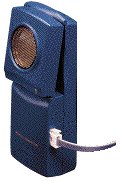The motion detector we used in our labs, tutorials, and ILDs measures distance to the nearest object by using a speaker and a microphone. The speaker clickes 30 times a second. The microphone detects the sound bouncing back from the nearest object in front of it. The computer calculates the time delay between the making of the sound and receiving the echo. It knows the speed of sound (about 343 m/s at room temperature) and from that, it can calculate the distance to the object from the time delay.
- If the nearest object in front of the detector is too far away, the echo will not get back before a second click is emitted. Once that happens, the computer has no way of knowing that the echo isn't an echo from the second click and the detector doesn't give correct results anymore. How far away does the object have to be before that happens?
- The speed of sound changes
a little bit with temperature. Let's try to get an idea of how important
this is. At room temperature (72 oF) the speed of sound is
about 343 m/s. At 62 oF it is about 1% smaller. Suppose
we are measuring an object that is really 1.5 meters away at 72 oF.
What is the time delay Δt that the computer detects before the echo
returns? Now suppose the temperature is 62 oF. If the computer
detects a time delay of Δt but (because it doesn't know the temperature)
calculates the distance using the speed of sound appropriate for 72 oF, how far away would the computer report the object is?
|
 |

